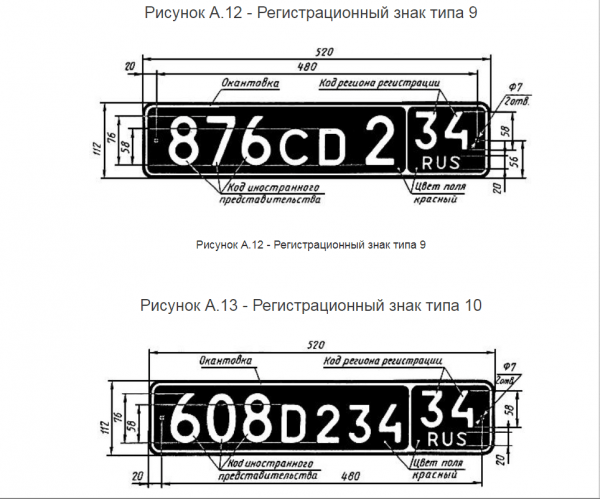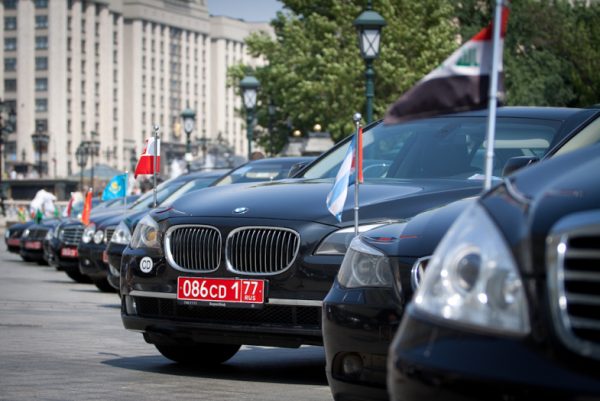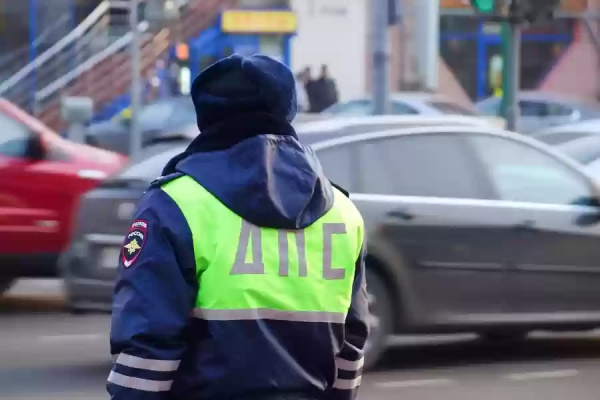
Red license plates in Russia and around the world
Content
Vehicles with red registration plates can often be found on public roads both in Russia and abroad. Therefore, it is useful to understand what they mean and how to behave with their owners.
Red car numbers: what do they mean
The basic provisions on vehicle registration plates in Russia are set out in two documents:
- in GOST R 50577–93 “Signs for state registration of vehicles. Types and basic dimensions. Technical requirements (with Amendments No. 1, 2, 3, 4)”;
- in the Order of the Ministry of Internal Affairs of Russia dated October 5, 2017 No. 766 "On state registration plates of vehicles".
The first document reflects the technical side of the issue: the parameters of the license plate, among other things, color, dimensions, material, and so on. The mentioned Order of the Ministry of Internal Affairs approved the lists of digital codes of the constituent entities of the Russian Federation, as well as codes of vehicle numbers of diplomatic missions, consulates, including honorary ones, international organizations and their employees accredited with the Ministry of Foreign Affairs of the Russian Federation.
Appendix A to GOST R 50577–93 contains an illustrated list of all types of license plates approved for use in Russia. Among them, let's pay special attention to registration plates of type 9 and 10: the only ones whose background color is red. Such car numbers, as stated in the state standard, are issued for vehicles of foreign missions in the Russian Federation accredited by the Russian Foreign Ministry.

At the same time, registration plates of type 9 can belong only to the heads of diplomatic missions (ambassador level), and type 10 - for other employees of embassies, consulates and international organizations.
In addition to the background color of license plates, a curious car enthusiast should pay attention to the numbers and letters written on them. It is this information that will allow you to find out a significant share of the information about the owner of the vehicle.
Learn how to apply for an international driving license: https://bumper.guru/voditelskie-prava/mezhdunarodnoe-voditelskoe-udostoverenie.html
Letter symbols
By the letters on the red license plates, you can determine the rank of an employee of a foreign mission.
According to paragraph 2 of the Order of the Ministry of Internal Affairs of Russia dated October 5, 2017 No. 766 “On state registration plates of vehicles”, the following letter designations are used:
The CD series is for cars of the heads of diplomatic missions.
 Registration plates of the "CD" series can only be placed on cars of the heads of diplomatic missions
Registration plates of the "CD" series can only be placed on cars of the heads of diplomatic missionsSeries D - for vehicles of diplomatic missions, consular institutions, including those headed by honorary consular officials, international (interstate) organizations and their employees accredited by the Ministry of Foreign Affairs of the Russian Federation and having diplomatic or consular cards.
 Numbers of the "D" series can be placed on cars of employees of foreign missions with diplomatic status
Numbers of the "D" series can be placed on cars of employees of foreign missions with diplomatic statusSeries T - for vehicles of employees of diplomatic missions, consular offices, with the exception of consular offices headed by honorary consular officials, international (interstate) organizations accredited by the Ministry of Foreign Affairs of the Russian Federation and having service cards or certificates.
 Car numbers of the "T" series are issued for cars of administrative and technical personnel who do not have diplomatic status
Car numbers of the "T" series are issued for cars of administrative and technical personnel who do not have diplomatic status
Numerical designations
In addition to letters, "diplomatic numbers" contain a three-digit numeric code. It indicates the nationality of a diplomatic or consular institution or the name of an international organization. Appendix 2 to the Order of the Ministry of Internal Affairs of Russia dated October 5, 2017 No. 766 assigns an individual digital code to each state or international organization. Numbers from 001 to 170 belong to states, from 499 to 560 - to international (interstate) organizations, 900 - to consular institutions, including honorary ones, regardless of the country they represent.
It is noteworthy that the numbering in this appendix corresponds to the order in which diplomatic relations of various countries with the Soviet Union arose in the period from 1924 to 1992.
In addition to their own codes, on red car numbers, like on any other Russian ones, the region code from Appendix 1 of the Order of the Ministry of Internal Affairs of Russia No. 766 is indicated on the right side of the registration plate.
Table: codes of representative offices of some states and international organizations
| Traffic police code | Foreign Representation |
| 001 | United Kingdom |
| 002 | Germany |
| 004 | USA |
| 007 | France |
| 069 | Finland |
| 499 | EU Delegation |
| 511 | UN Representation |
| 520 | The International Labour Organization |
| 900 | Honorary Consuls |
Who has the right to install red car numbers
Only employees of diplomatic and consular institutions, as well as international (interstate) organizations, have the right to install registration plates with a red background. It is important to note that not only diplomatic agents have such a right, but also the administrative and technical staff of a foreign mission. Finally, for additional protection, a special legal status is granted to family members living with them.
In accordance with Part 3 of Article 12.2 of the Code of Administrative Offenses (Code of Administrative Offenses) of the Russian Federation, the use of false state numbers on a vehicle is punishable by a fine of 2500 rubles for citizens, from 15000 to 20000 rubles for officials, and for legal entities - from 400000 to 500000 rubles. The same article in part 4 establishes an even more serious punishment for driving a car with fake numbers: deprivation of rights for a period of 6 months to 1 year.

Given the unreliability and danger of establishing fictitious numbers, those who want to make it easier for themselves to use a car have found ways to “get around” the law. Firstly, having connections, many wealthy businessmen and semi-criminal elements received these numbers for material reward, and therefore the privileges due to their holders through the embassies of small states. Secondly, it was quite legal to obtain type 9 numbers for citizens who became honorary consuls. Examples of the most egregious stories of the uncontrolled issuance of license plates from embassies and consulates can be found in the press (see, for example: an article in the newspaper Argumenty i Fakty or Kommersant).
Legal status of cars owned by foreign representative offices in the Russian Federation
Special red car plates, adopted in our country to designate the cars of diplomatic missions, perform an important function: they allow traffic police officers to distinguish cars with a special legal status in the traffic flow. In accordance with Part 3 of Art. 22 of the 1961 Convention on Diplomatic Relations concluded in Vienna, and Part 4 of Art. 31 of the 1963 Vienna Convention on Consular Relations, vehicles of diplomatic missions and consulates are immune from searches, requisitions (seizures by authorities), arrest and other executive actions.
In addition to cars, of course, the diplomats themselves, employees of consular offices have immunities in accordance with their status. For example, Article 31 of the Vienna Convention of 1963 recognizes immunity from the criminal jurisdiction of the host country, as well as administrative and civil jurisdiction, with minor restrictions, for diplomatic agents. That is, a diplomatic agent, as well as other employees of foreign missions, cannot be held liable by state bodies in any way, unless the accrediting state waives their immunity (Article 32 of the 1961 Vienna Convention).
Immunity does not mean complete impunity for an employee of a diplomatic mission or consular office, since he can be held accountable by the state that sent him to the Russian Federation.

What is said in international treaties ratified by Russia has priority over national legislation by virtue of Part 4 of Art. 15 of the Constitution of the Russian Federation, therefore, the rules on the immunities of motor vehicles are also reflected in our laws. In the new administrative regulation of the traffic police (Order of the Ministry of Internal Affairs of Russia dated August 23.08.2017, 664 N 292), a separate section is devoted to the rules on interaction with vehicles of persons who have immunity from administrative jurisdiction. In accordance with paragraph XNUMX of the Order of the Ministry of Internal Affairs, only the following administrative measures can be applied to foreign citizens enjoying immunity:
- supervision of traffic, including the use of technical means and special technical means operating in automatic mode;
- stopping the vehicle;
- pedestrian stop;
- verification of documents, state registration plates of the vehicle, as well as the technical condition of the vehicle in operation;
- drawing up a protocol on an administrative offense;
- issuing a ruling on initiating a case on an administrative offense and conducting an administrative investigation;
- issuance of a ruling on the refusal to initiate a case on an administrative offense;
- examination for the state of alcoholic intoxication;
- referral for a medical examination for intoxication;
- issuance of a decision on the case of an administrative offense;
- drawing up a protocol of inspection of the place of committing an administrative offense.
Learn how to check a car by VIN: https://bumper.guru/pokupka-prodazha/gibdd-proverka-avtomobilya.html
But the police officers do not have the authority to attract foreign citizens with immunity from the administrative jurisdiction of the Russian Federation. According to paragraph 295 of the Order of the Ministry of Internal Affairs, in cases where a vehicle creates a danger to others, police officers have the right to stop a car with diplomatic plates using the means available to it. They are obliged to immediately report this to their colleagues in the department of the Ministry of Internal Affairs at the district level. They must also convey information about the incident to the Russian Ministry of Foreign Affairs and the diplomatic mission that owns the car. Traffic police officers themselves are not entitled to enter the car and somehow contact the driver and passengers without their consent.

Otherwise, vehicles with red numbers are subject to the general rules of the road and do not have advantages over other road users. Exceptions to the rules usually occur when passing diplomatic motorcades accompanied by traffic police cars using special signals in accordance with Chapter 3 of the SDA. A vehicle with flashing lights on can ignore traffic lights, speed limits, maneuvering and overtaking rules, and others. Special funds, as a rule, are used only by heads of missions in cases of important and urgent negotiations.
More about traffic accidents: https://bumper.guru/dtp/chto-takoe-dtp.html
Red numbers on cars around the world
Many of our compatriots on trips abroad refuse public transport in favor of personal. It is important for them to learn the basic rules of behavior on the roads of the host country, which can differ significantly from Russian ones. The situation is the same with red license plates: depending on the state, they acquire different meanings.
Ukraine
Ukrainian red license plates with white and black alphabetic and numeric characters denote transit vehicles. Since they are issued for a limited period, the material for the registration plate is plastic, not metal. In addition, the month of issue is indicated on the number itself, so that it is easier to set a deadline for use.

Belarus
In the Union Republic, red license plates, as in our country, are issued for vehicles of foreign missions. There is only one exception: a high-ranking officer of the Ministry of Internal Affairs of the Republic of Belarus may turn out to be the owner of a car with a red number.
Europe
In the European Union, a single model for the use of red car plates has not been developed. In Bulgaria and Denmark, cars with red registration plates serve airports. In Belgium, standard numbers are in red. In Greece, taxi drivers got red numbers. And Hungary they are endowed with transport capable of developing only low speed.
Video: about the use of red numbers in modern Germany
Asia
In Armenia, Mongolia and Kazakhstan, red license plates, as in Russia, are the prerogative of foreign representatives.
In Turkey, there are two types of numbers with a red background:
- for government vehicles;
- for rectors and employees of local administrations.
USA
The United States is a federal state by government, so the authority to set standards for car registration plates belongs to each state individually. For example, in Pennsylvania, emergency vehicles receive red plates, and in Ohio, red print on a yellow background highlights drunk drivers on the road.
Other countries
In Canada, standard license plates are in red on a white background. While in Brazil, the red background of license plates is inherent in public transport.
Car registration plates in red in the countries of the world have different purposes. They have one thing in common - the desire of the public authorities to highlight the vehicle in the traffic flow, to make it visible to surrounding pedestrians, drivers and police officers. In Russia, red numbers are traditionally owned by diplomats. The bright colors of the plates are intended to indicate the special status of a vehicle of a diplomatic mission or other foreign institution.




